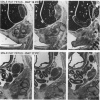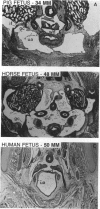Abstract
There is need for a consistent definition of structures caudal to the testis that variously are termed 'gubernaculum testis' as a basis for understanding the emergence and sexually dimorphic further growth and differentiation of this specifically mammalian structure. Rodent fetuses undergo a stage of development during which there is almost complete unanimity as to the definition of the 'gubernaculum' as a papilla-like structure (often called conus inguinalis) protruding from the area of the internal inguinal ring. This structure shows at least 3 readily distinguishable components before birth. Postnatally, the papilla-like gubernaculum starts to undergo inversion to become the tunica of the sac-like processus vaginalis. The 3 components of the fetal gubernaculum develop further uninterruptedly, but with a different spatial arrangement, as parts of the wall of a sac rather than as parts of a papilla-like structure. Comparison of this process in rodents with that in other mammals (pig, horse, man) revealed an essentially identical emergence of a papilla-shaped gubernaculum with similar constituents. Initial development of the processus vaginalis also began with the inversion of the gubernacular papilla. Cattle fetuses appeared exceptional as outgrowth of the processus vaginalis occurred without a preceding papilla-shaped gubernaculum in the area of the inner inguinal ring. The findings lead to the following conclusions. (1) In rodents, the whole of the postnatally developing processus vaginalis, including therefore its cremasteric muscles but without the attached genital mesentery, is to be viewed as the male postnatal gubernaculum. Sexual differentiation of the gubernacular primordia includes a sex-specific effect on the morphogenesis of all constituents of the processus vaginalis sac including cremasteric muscle cells. (2) Gubernacular growth and differentiation appear essentially a uniform process throughout the placentalia mammalian class; only quantitative differences occur in the extent of initial development of an intra-abdominal conus inguinalis and later cremaster muscles.
Full text
PDF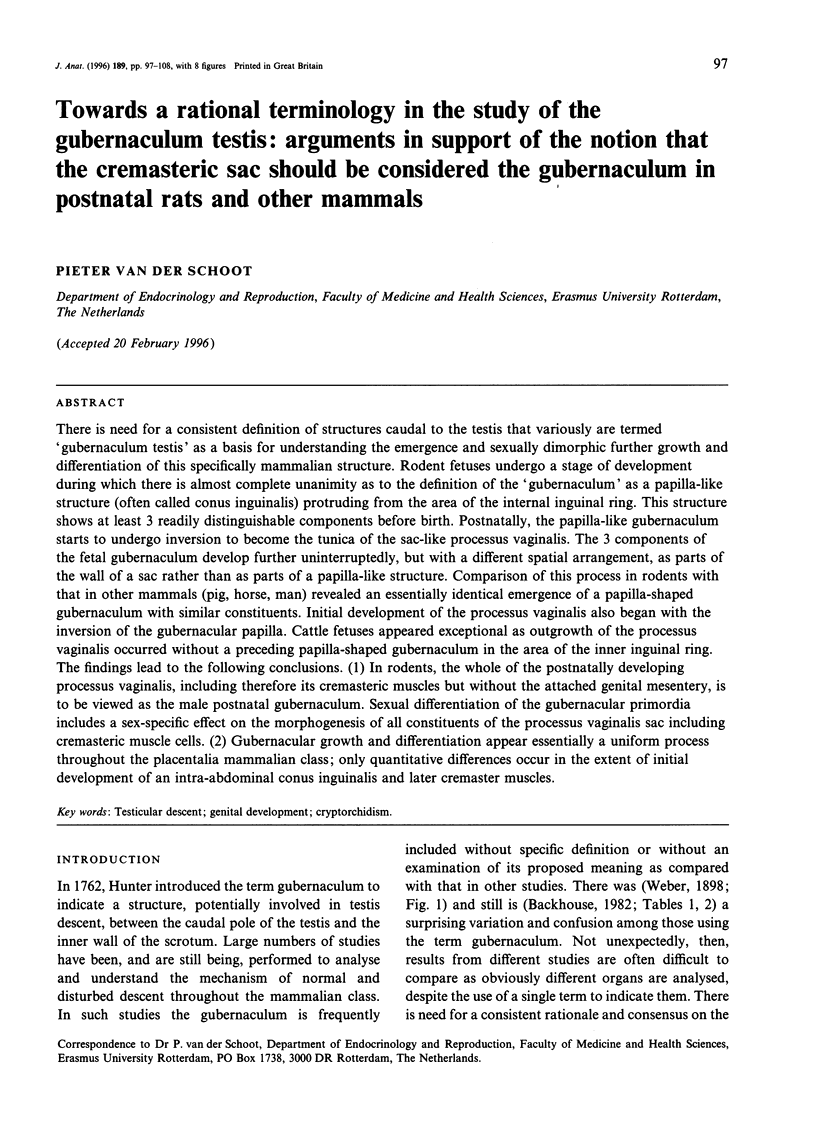
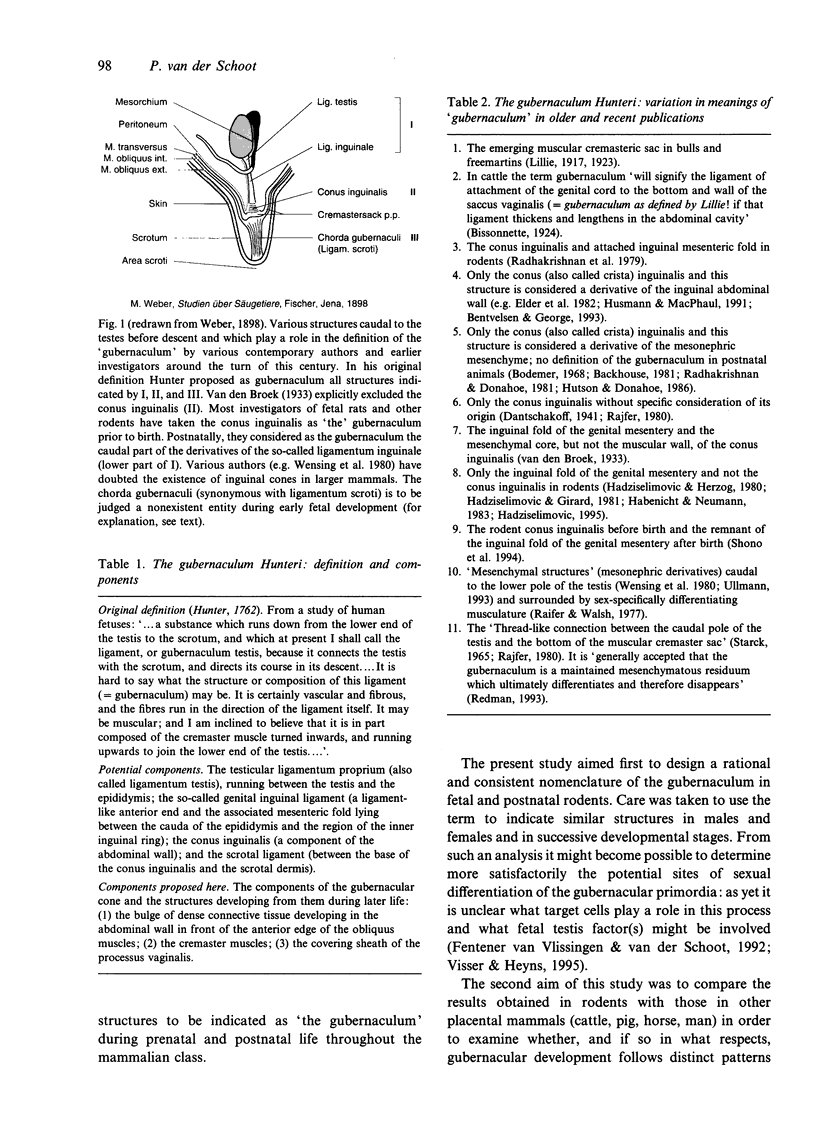
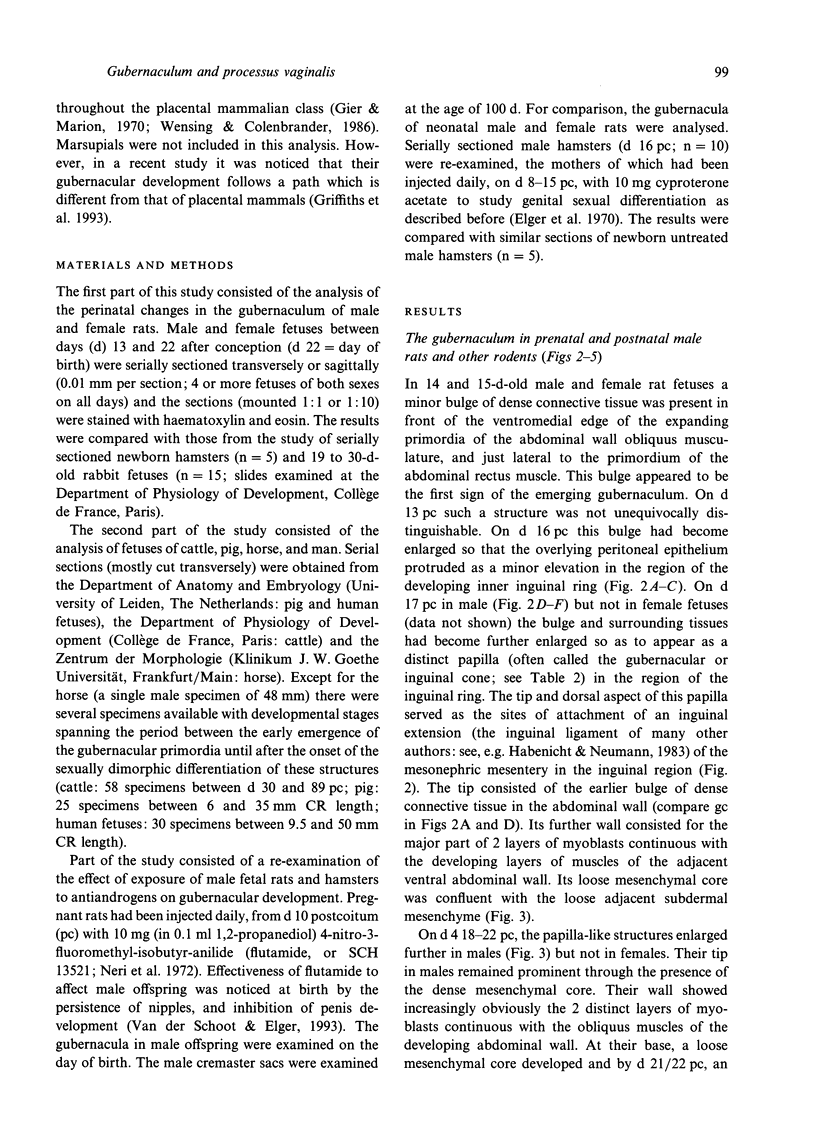
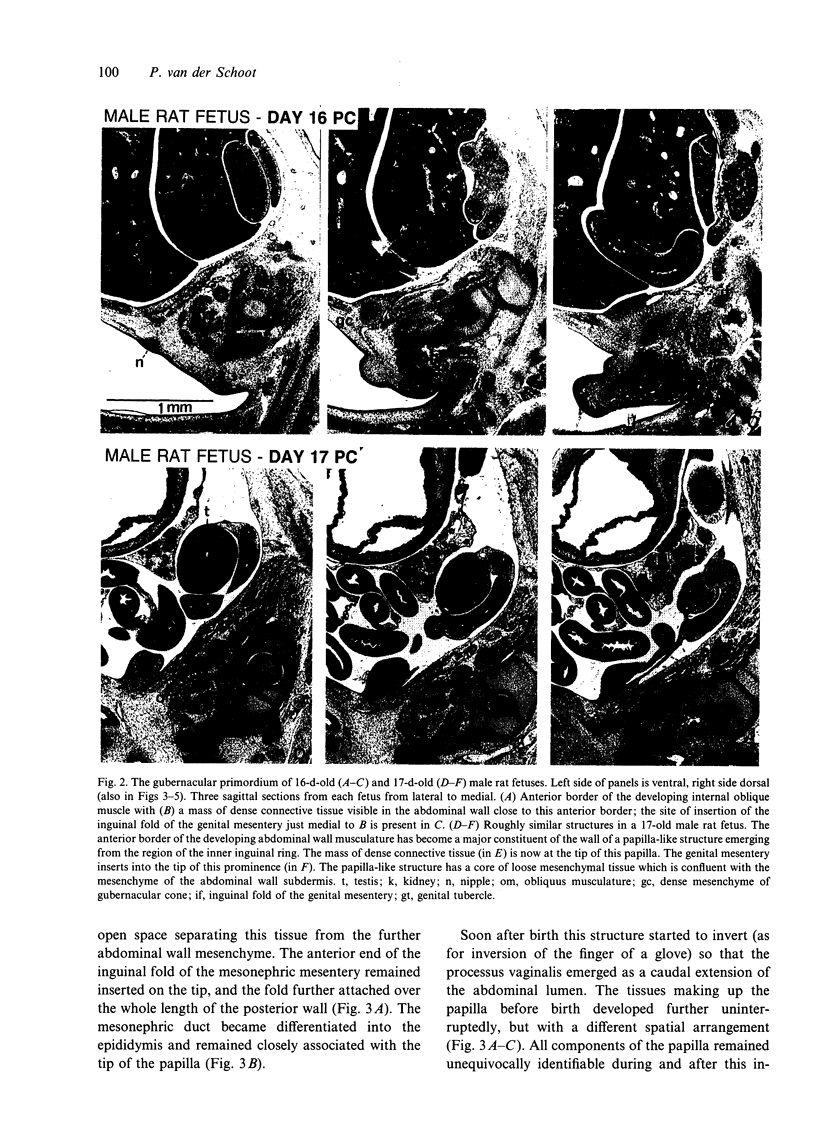
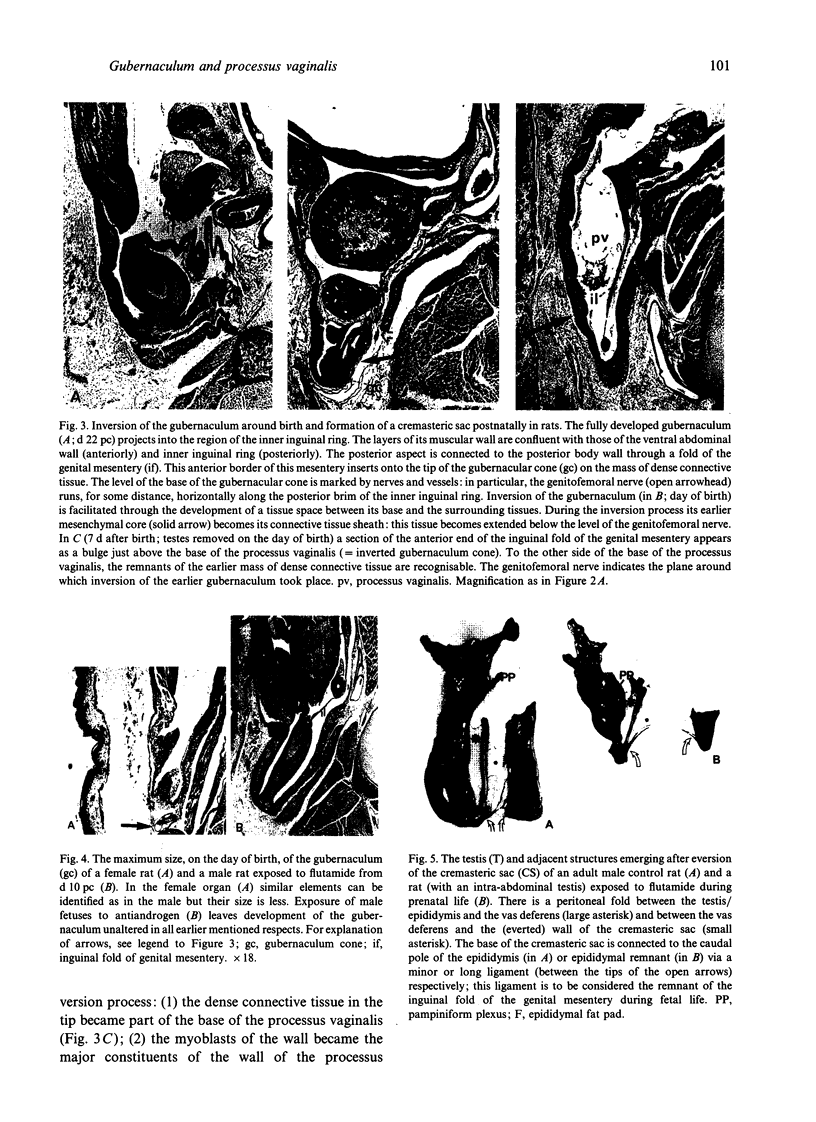
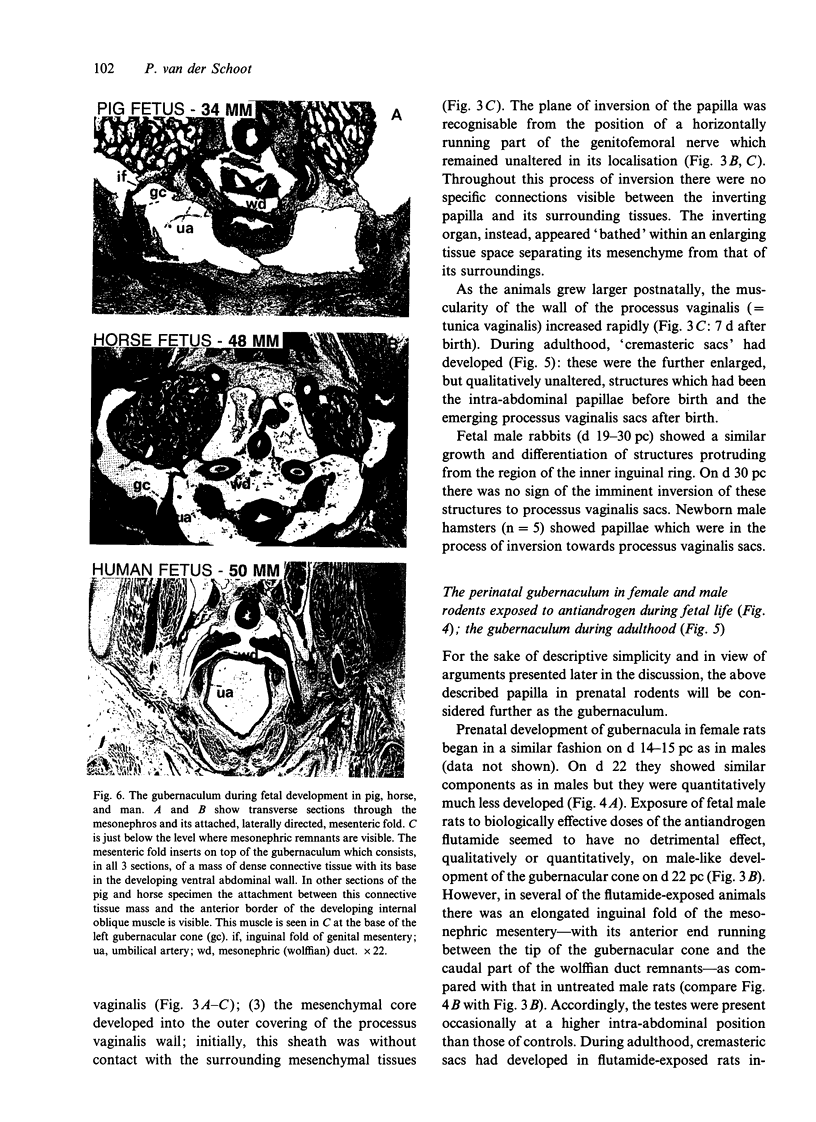
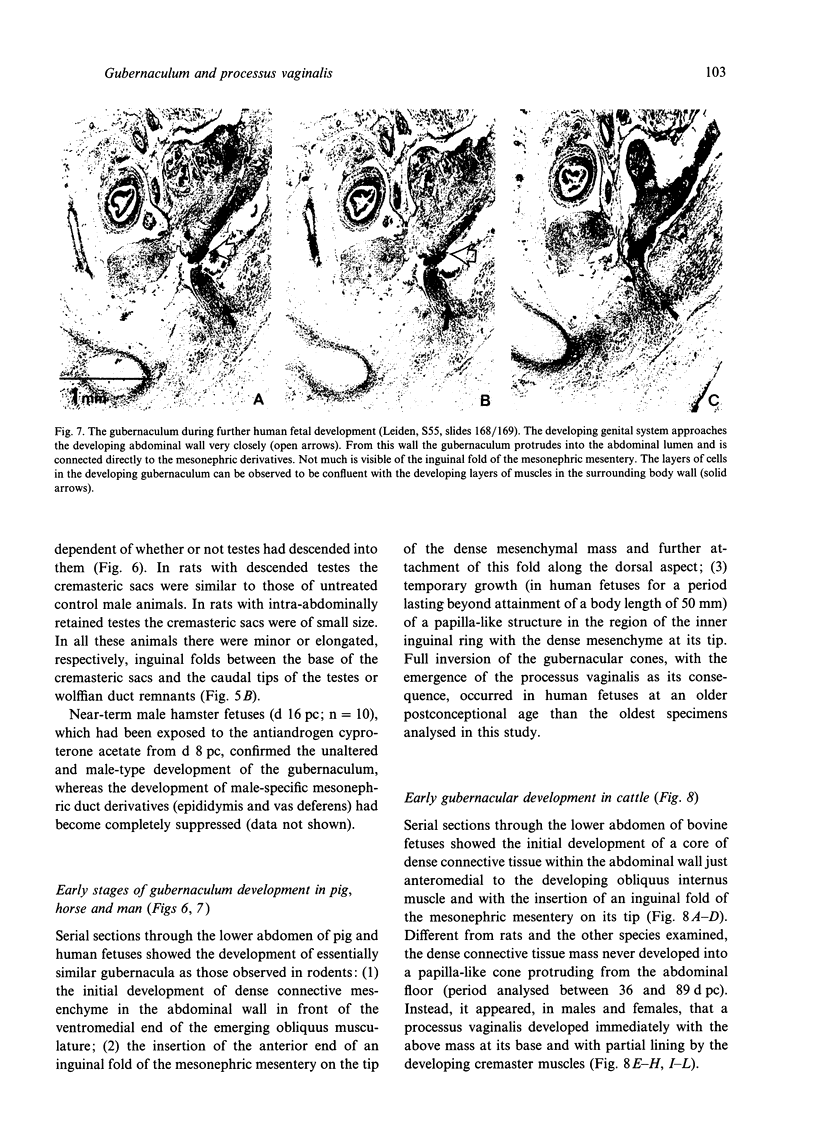
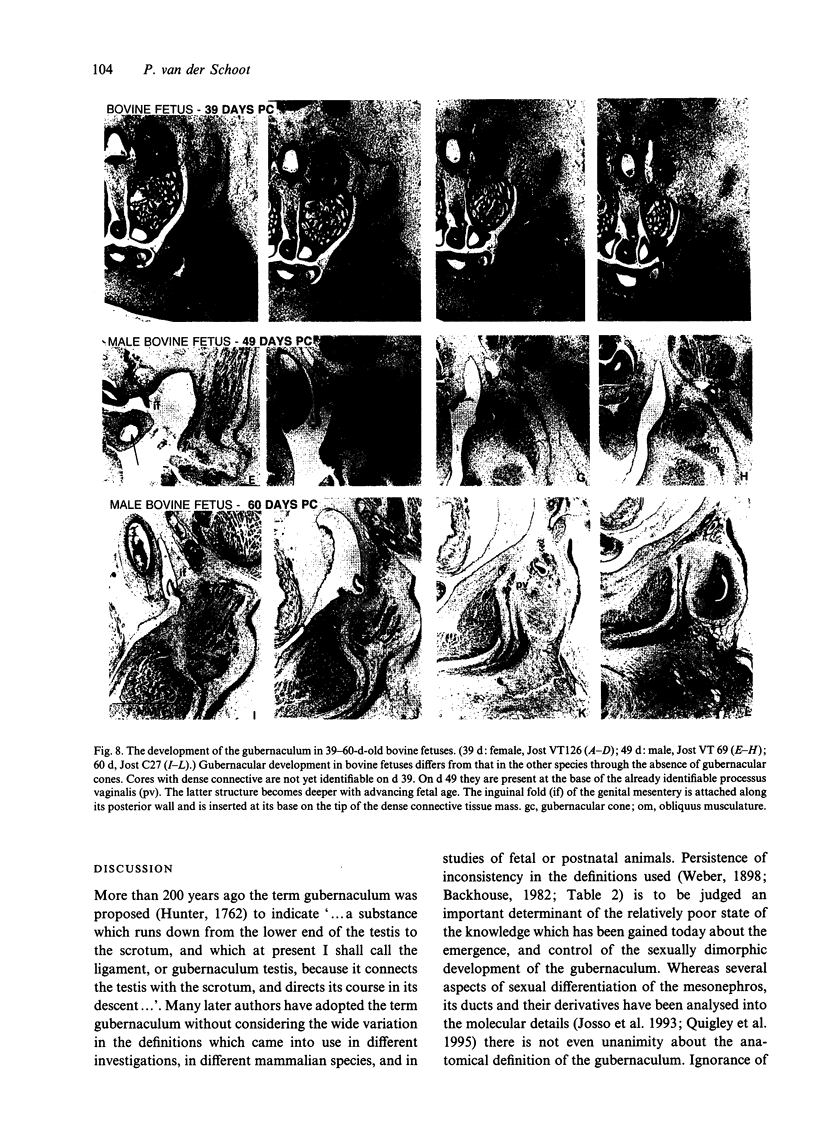
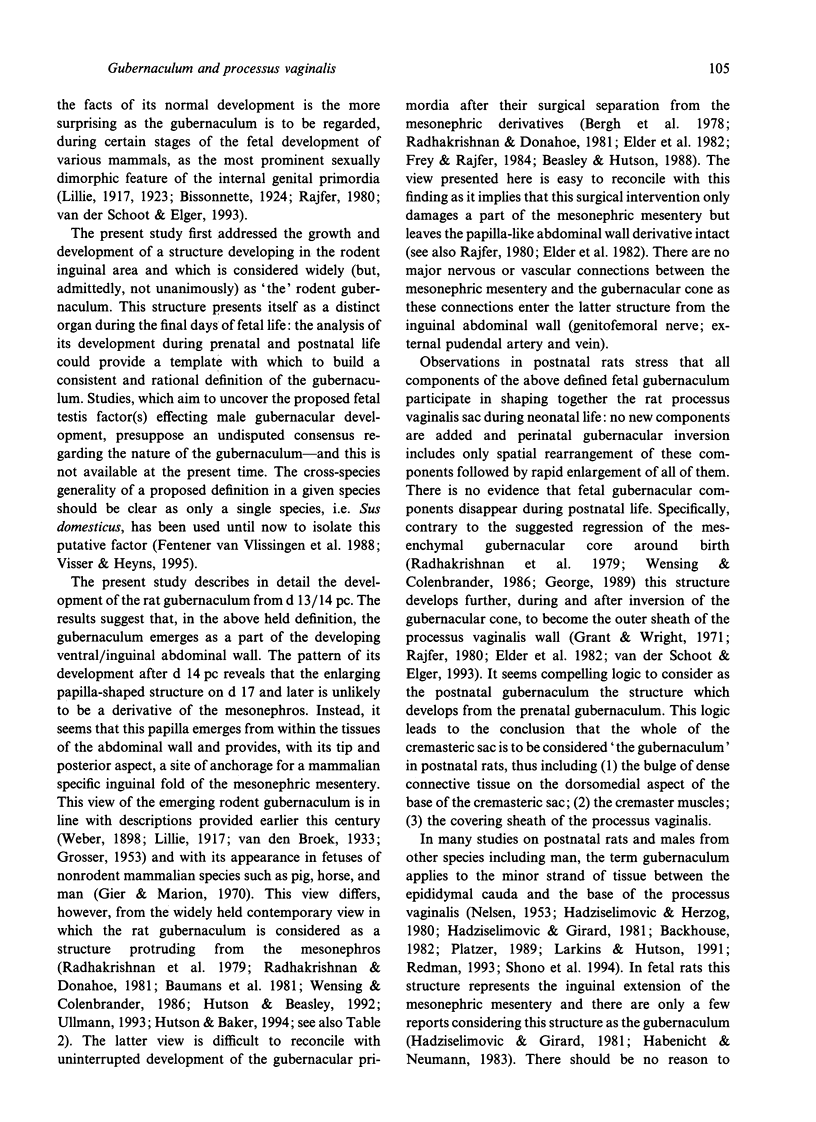
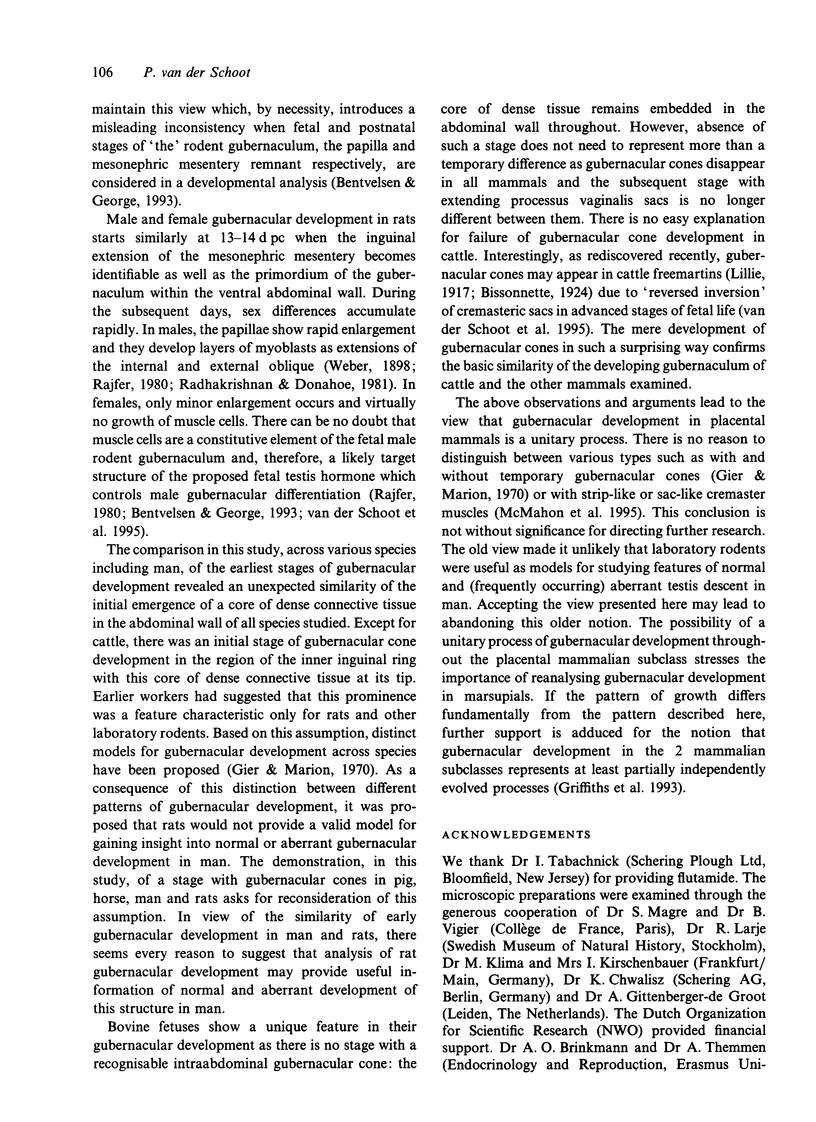
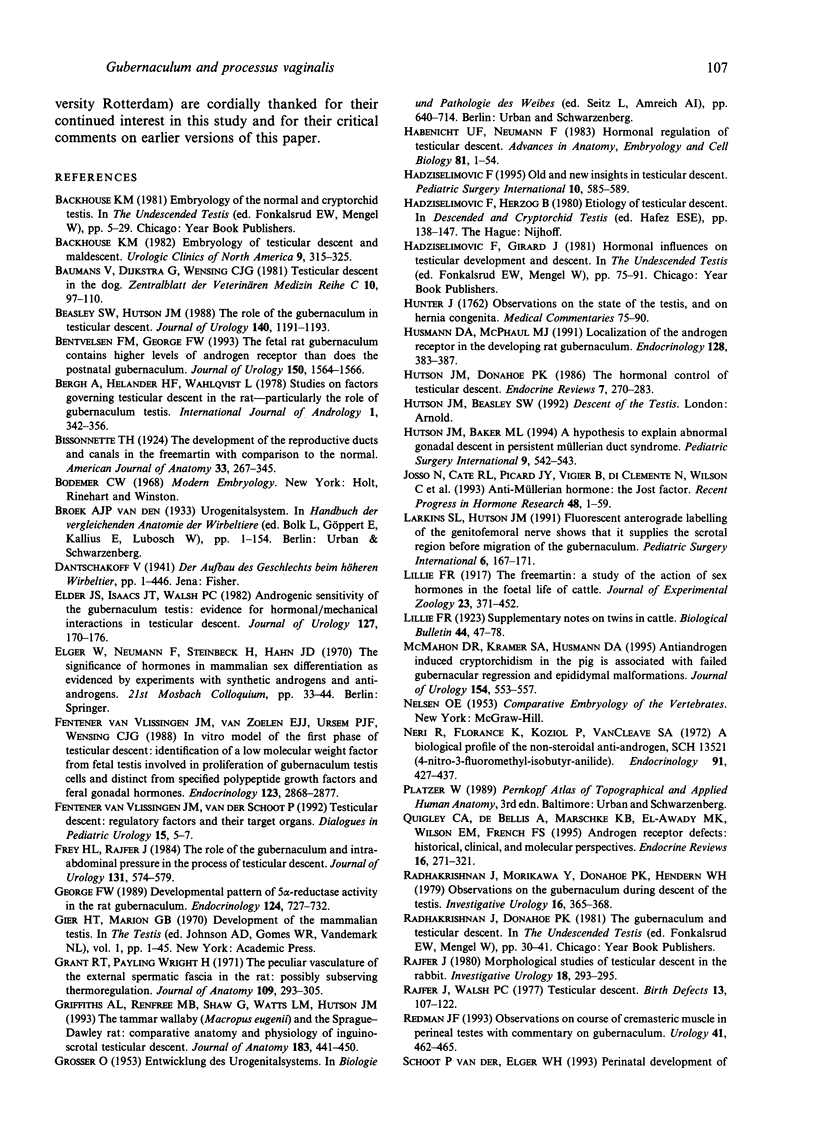
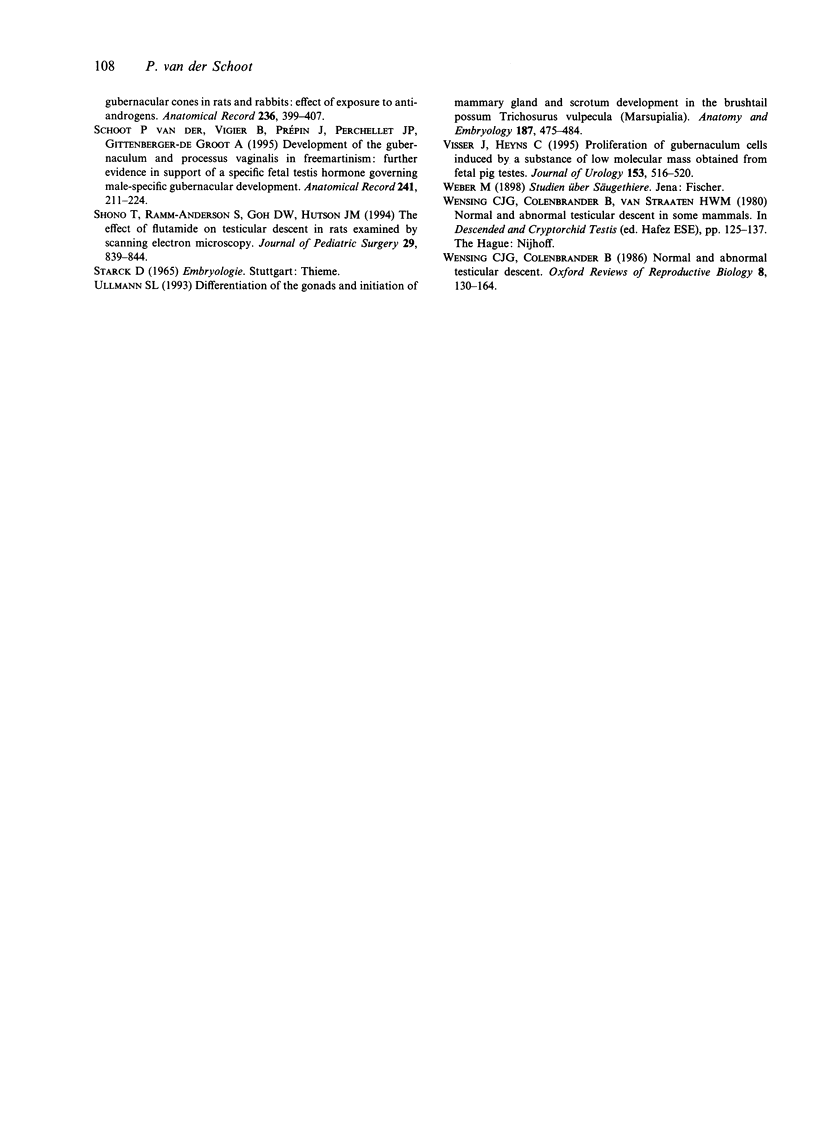
Images in this article
Selected References
These references are in PubMed. This may not be the complete list of references from this article.
- Backhouse K. M. Embryology of testicular descent and maldescent. Urol Clin North Am. 1982 Oct;9(3):315–325. [PubMed] [Google Scholar]
- Baumans V., Dijkstra G., Wensing C. J. Testicular descent in the dog. Anat Histol Embryol. 1981 Jun;10(2):97–110. doi: 10.1111/j.1439-0264.1981.tb00508.x. [DOI] [PubMed] [Google Scholar]
- Beasley S. W., Hutson J. M. The role of the gubernaculum in testicular descent. J Urol. 1988 Nov;140(5 Pt 2):1191–1193. doi: 10.1016/s0022-5347(17)41998-7. [DOI] [PubMed] [Google Scholar]
- Bentvelsen F. M., George F. W. The fetal rat gubernaculum contains higher levels of androgen receptor than does the postnatal gubernaculum. J Urol. 1993 Nov;150(5 Pt 1):1564–1566. doi: 10.1016/s0022-5347(17)35842-1. [DOI] [PubMed] [Google Scholar]
- Elder J. S., Isaacs J. T., Walsh P. C. Androgenic sensitivity of the gubernaculum testis: evidence for hormonal/mechanical interactions in testicular descent. J Urol. 1982 Jan;127(1):170–176. doi: 10.1016/s0022-5347(17)53655-1. [DOI] [PubMed] [Google Scholar]
- Fentener van Vlissingen J. M., van Zoelen E. J., Ursem P. J., Wensing C. J. In vitro model of the first phase of testicular descent: identification of a low molecular weight factor from fetal testis involved in proliferation of gubernaculum testis cells and distinct from specified polypeptide growth factors and fetal gonadal hormones. Endocrinology. 1988 Dec;123(6):2868–2877. doi: 10.1210/endo-123-6-2868. [DOI] [PubMed] [Google Scholar]
- Frey H. L., Rajfer J. Role of the gubernaculum and intraabdominal pressure in the process of testicular descent. J Urol. 1984 Mar;131(3):574–579. doi: 10.1016/s0022-5347(17)50507-8. [DOI] [PubMed] [Google Scholar]
- George F. W. Developmental pattern of 5 alpha-reductase activity in the rat gubernaculum. Endocrinology. 1989 Feb;124(2):727–732. doi: 10.1210/endo-124-2-727. [DOI] [PubMed] [Google Scholar]
- Grant R. T., Wright H. P. The peculiar vasculature of the external spermatic fascia in the rat; possible subserving thermoregulation. J Anat. 1971 Jul;109(Pt 2):293–305. [PMC free article] [PubMed] [Google Scholar]
- Griffiths A. L., Renfree M. B., Shaw G., Watts L. M., Hutson J. M. The tammar wallaby (Macropus eugenii) and the Sprague-Dawley rat: comparative anatomy and physiology of inguinoscrotal testicular descent. J Anat. 1993 Dec;183(Pt 3):441–450. [PMC free article] [PubMed] [Google Scholar]
- Habenicht U. F., Neumann F. Hormonal regulation of testicular descent. Adv Anat Embryol Cell Biol. 1983;81:1–54. doi: 10.1007/978-3-642-69121-8. [DOI] [PubMed] [Google Scholar]
- Husmann D. A., McPhaul M. J. Localization of the androgen receptor in the developing rat gubernaculum. Endocrinology. 1991 Jan;128(1):383–387. doi: 10.1210/endo-128-1-383. [DOI] [PubMed] [Google Scholar]
- Hutson J. M., Donahoe P. K. The hormonal control of testicular descent. Endocr Rev. 1986 Aug;7(3):270–283. doi: 10.1210/edrv-7-3-270. [DOI] [PubMed] [Google Scholar]
- Josso N., Cate R. L., Picard J. Y., Vigier B., di Clemente N., Wilson C., Imbeaud S., Pepinsky R. B., Guerrier D., Boussin L. Anti-müllerian hormone: the Jost factor. Recent Prog Horm Res. 1993;48:1–59. doi: 10.1016/b978-0-12-571148-7.50005-1. [DOI] [PubMed] [Google Scholar]
- McMahon D. R., Kramer S. A., Husmann D. A. Antiandrogen induced cryptorchidism in the pig is associated with failed gubernacular regression and epididymal malformations. J Urol. 1995 Aug;154(2 Pt 1):553–557. doi: 10.1097/00005392-199508000-00068. [DOI] [PubMed] [Google Scholar]
- Neri R., Florance K., Koziol P., Van Cleave S. A biological profile of a nonsteroidal antiandrogen, SCH 13521 (4'-nitro-3'trifluoromethylisobutyranilide). Endocrinology. 1972 Aug;91(2):427–437. doi: 10.1210/endo-91-2-427. [DOI] [PubMed] [Google Scholar]
- Quigley C. A., De Bellis A., Marschke K. B., el-Awady M. K., Wilson E. M., French F. S. Androgen receptor defects: historical, clinical, and molecular perspectives. Endocr Rev. 1995 Jun;16(3):271–321. doi: 10.1210/edrv-16-3-271. [DOI] [PubMed] [Google Scholar]
- Radhakrishnan J., Morikawa Y., Donahoe P. K., Hendren W. H. Observations on the gubernaculum during descent of the testis. Invest Urol. 1979 Mar;16(5):365–368. [PubMed] [Google Scholar]
- Rajfer J. Morphological study of testicular descent in the rabbit. Invest Urol. 1981 Jan;18(4):293–295. [PubMed] [Google Scholar]
- Rajfer J., Walsh P. C. Testicular descent. Birth Defects Orig Artic Ser. 1977;13(2):107–122. [PubMed] [Google Scholar]
- Redman J. F. Observations on course of cremasteric muscle in perineal testes with commentary on gubernaculum. Urology. 1993 May;41(5):462–465. doi: 10.1016/0090-4295(93)90509-9. [DOI] [PubMed] [Google Scholar]
- Shono T., Ramm-Anderson S., Goh D. W., Hutson J. M. The effect of flutamide on testicular descent in rats examined by scanning electron microscopy. J Pediatr Surg. 1994 Jun;29(6):839–844. doi: 10.1016/0022-3468(94)90384-0. [DOI] [PubMed] [Google Scholar]
- Ullmann S. L. Differentiation of the gonads and initiation of mammary gland and scrotum development in the brushtail possum Trichosurus vulpecula (Marsupialia). Anat Embryol (Berl) 1993 May;187(5):475–484. doi: 10.1007/BF00174423. [DOI] [PubMed] [Google Scholar]
- Visser J. H., Heyns C. F. Proliferation of gubernaculum cells induced by a substance of low molecular mass obtained from fetal pig testes. J Urol. 1995 Feb;153(2):516–520. doi: 10.1097/00005392-199502000-00074. [DOI] [PubMed] [Google Scholar]
- Wensing C. J., Colenbrander B. Normal and abnormal testicular descent. Oxf Rev Reprod Biol. 1986;8:130–164. [PubMed] [Google Scholar]
- van der Schoot P., Vigier B., Prepin J., Perchellet J. P., Gittenberger-de Groot A. Development of the gubernaculum and processus vaginalis in freemartinism: further evidence in support of a specific fetal testis hormone governing male-specific gubernacular development. Anat Rec. 1995 Feb;241(2):211–224. doi: 10.1002/ar.1092410208. [DOI] [PubMed] [Google Scholar]




